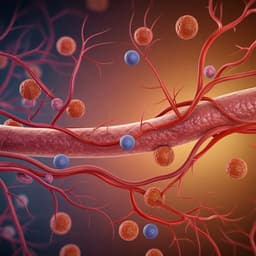
Medicine and Health
Effects of basic carbohydrate counting versus standard dietary care for glycaemic control in type 2 diabetes (The BCC Study): a randomised, controlled trial
B. Ewers, M. B. Blond, et al.
This randomized controlled trial conducted by Bettina Ewers, Martin B. Blond, Jens M. Bruun, and Tina Vilsbøll explored the effectiveness of a structured carbohydrate counting education program for individuals with type 2 diabetes. While significant glycemic improvements were not achieved, participants notably enhanced their carbohydrate estimation skills, emphasizing the intricate nature of diabetes management.
~3 min • Beginner • English
Introduction
Type 2 diabetes (T2D) requires continuous self-management, making evidence-based education—especially on diet and nutrition—critical to prevent complications and improve quality of life. Major diabetes organizations endorse multiple eating patterns (e.g., low-fat, Mediterranean, high-protein, moderate- or low-carbohydrate, low glycaemic index/load, vegetarian, paleolithic), many of which improve glycaemic control. Compared to these patterns, carbohydrate counting aims to manage and balance carbohydrate amounts at meals. Advanced carbohydrate counting is well established in type 1 diabetes and has shown benefits in T2D when combined with basal–bolus insulin, but evidence for basic carbohydrate counting (BCC) as a stand-alone dietary approach in T2D is scarce. Accuracy in carbohydrate estimation is considered an intermediate marker potentially influencing glycaemic control; evidence—mainly from T1D—has been mixed. Multiple educational approaches to BCC (gram counting, exchanges, experience-based estimation) exist but have not been thoroughly evaluated in clinical trials. Improving carbohydrate estimation skills and encouraging consistent carbohydrate intake could reduce glucose variability and hyperglycaemia, potentially lowering HbA1c. Aim and hypothesis: To examine whether a structured education program in BCC, as an add-on to standard dietary care, improves glycaemic control (HbA1c and mean amplitude of glycaemic excursions [MAGE]) compared with standard dietary care in individuals with T2D; the hypothesis was that BCC would be superior for improving these outcomes.
Literature Review
Guidelines from European and American diabetes associations endorse various eating patterns that can improve glycaemic control in T2D. A network meta-analysis indicates several dietary approaches improve glycaemia. Advanced carbohydrate counting benefits T1D and has some positive effects in T2D with basal–bolus insulin, but the effectiveness of basic carbohydrate counting (BCC) in T2D remains under-studied. Evidence linking improved carbohydrate estimation accuracy to better glycaemic outcomes is mixed, with some studies (primarily in T1D) showing associations and others not. Educational approaches to BCC (gram counting, exchanges, experience-based estimation) are used in practice but have not been rigorously tested in trials. The literature also suggests that literacy and numeracy influence nutrition label understanding and portion-size estimation, potentially moderating the effectiveness of carbohydrate counting strategies.
Methodology
Design: Single-center, randomized, controlled, open-label, parallel-group, superiority trial conducted at the outpatient clinic at Steno Diabetes Center Copenhagen, Denmark. Total study duration per participant: 12 months (6-month intervention plus 6-month follow-up). Registration: ClinicalTrials.gov NCT03623139. Ethics: Approved by the Regional Scientific Ethics Committee of the Capital Region of Denmark (H-18014918); conducted per the Helsinki Declaration; GDPR-compliant (VD-2018-233, I-Suite 6474). Timeline: Enrollment from 28 Sep 2018 to 12 Jul 2021. Participants: Adults aged 18–75 years with T2D ≥12 months, HbA1c 53–97 mmol/mol (7.0–11.0%), treated with diet and/or any glucose-lowering medication, and followed at Steno Diabetes Center Copenhagen. Key exclusions: Current carbohydrate counting practice or participation in BCC within 2 years, automated bolus calculator use, very low daily carbohydrate intake (<25 E% or <100 g/day), gastroparesis, medical issues affecting intake, pregnancy/breastfeeding/planned pregnancy, participation in other trials, or inability to consent. Screening and randomization: Interested and eligible individuals provided informed consent and were randomized 1:1 to BCC or standard dietary care via a REDCap randomization module using a list generated by an external statistician. Interventions: - Standard dietary care (control): Three individual dietitian counseling sessions totaling 2 hours (approximately at weeks 0, 2, and 12). - BCC program (add-on): In addition to the same three individual sessions, participants attended a structured group course (4–8 participants) totaling 8 hours across sessions at weeks 2, 4, and 12, delivered by study dietitians. Content included theory on food and diabetes, problem-solving and hands-on activities to identify carbohydrate sources, practical measurement and calculation of carbohydrate content, and multiple monitoring approaches (gram counting using labels/tables, smartphone apps, visual estimation training). Participants kept a 4-day dietary and glucose log to quantify carbohydrate intake and variability, from which a personalized carbohydrate plan was developed. Peer discussion and support were included. Participants were advised not to change physical activity; medication changes were allowed per clinical indications. Outcomes: Primary outcomes were change from baseline to end-of-treatment (6 months) in HbA1c and glycaemic variability measured by MAGE from blinded CGM. Secondary/exploratory outcomes included mean glucose, time in range (TIR 3.9–10.0 mmol/L), time above range (TAR 10.1–13.9 mmol/L), coefficient of variation (CV) and SD for glucose, body weight, BMI, waist/hip ratio, blood pressure, LDL cholesterol, and carbohydrate estimation errors (grams and percentage), among others (see protocol). Sample size: Planned to detect between-group differences of 3 mmol/mol (0.3%) in HbA1c (SD 7 mmol/mol) and ≥0.3 mmol/L in MAGE (SD 0.7 mmol/L), with 80% power at α=0.05, allowing 30% dropout and subgroup analyses, yielding a target of 226 participants (113 per group). COVID-19 impact: National pandemic measures shifted elective visits to digital formats and paused enrollment (Mar–Sep 2020 and Nov 2020–Feb 2021), delaying study visits and scattering follow-ups; the trial was terminated in July 2021 before reaching the planned sample size, without prior data review. Statistical analysis: Intention-to-treat analyses used linear mixed-effects models with baseline correction (placing all participants at control baseline), fixed effects for visit and treatment-by-visit interaction, and assessment of residuals. Log-transformation was applied as needed; results were back-transformed. Treatment effects were estimated as baseline-corrected between-group differences with 95% CIs and two-sided p-values. Non-parametric Wilcoxon tests were used for psychometric scales. FDR was controlled at <5% using Benjamini–Hochberg for secondary/exploratory outcomes. Missing data were handled via maximum likelihood under missing at random. Software: SAS EG 8.3 and R 4.0.2.
Key Findings
- Enrollment and groups: 252 assessed; 48 randomized (23 BCC, 25 standard). Seven did not receive the allocated intervention. One dropout occurred before baseline measurements (Table notes show overall n=47 for baseline characteristics). Participants were ~62 years old, 68% male, diabetes duration median 16 years, baseline HbA1c median 63 mmol/mol (7.9%). High use of metformin (87%), GLP-1RAs (72%), SGLT-2 inhibitors (57%), and insulin (55%). - Primary outcomes at end-of-treatment (6 months): • HbA1c (baseline-adjusted mean 65 mmol/mol [8.1%]): BCC change −5 mmol/mol (95% CI −8 to −1; −0.5% [−0.7 to −0.1]); Standard change −3 mmol/mol (−7 to 1; −0.3% [−0.6 to 0.1]); Estimated treatment effect −2 mmol/mol (−7 to 4; −0.2% [−0.6 to 0.4]); p=0.554. • MAGE (baseline-adjusted mean 4.2 mmol/L [3.7 to 4.8]): BCC change −16% (−33 to 5); Standard change −3% (−21 to 20); Estimated treatment effect −14% (−36 to 16); p=0.319. - Secondary/exploratory outcomes (selected): • Carbohydrate estimation error: from baseline-adjusted mean 139% (95% CI 95–203), median estimation error decreased −71% (−80 to −58) in BCC vs −36% (−56 to −6) in standard; between-group treatment difference −55% (−70 to −32); p<0.001; remained significant after FDR adjustment. Grams-based median error also showed significant between-group difference at end-of-treatment (−71.0 g [−86.1 to −39.2]; p=0.002). • Mean plasma glucose: BCC −0.3 mmol/L (−1.3 to 0.6) vs standard −0.1 mmol/L (−1.0 to 0.8); between-group −0.2 mmol/L (−1.5 to 1.0); p=0.684. • TIR: BCC +4.1% (−7.1 to 15.2) vs standard +4.4% (−6.6 to 15.4); between-group −0.3% (−15.5 to 14.9); p=0.968. • CV for glucose: between-group +2.9% (−2.0 to 7.8); p=0.239. • Body weight: BCC −1.8 kg (−3.2 to −0.4) vs standard −0.7 kg (−2.2 to 0.9); between-group −1.2 kg (−3.3 to 1.0); p=0.277. • No significant between-group differences for BMI, waist/hip ratio, blood pressure, LDL cholesterol. - Overall: BCC improved carbohydrate estimation skills substantially, but did not improve HbA1c or glycaemic variability compared with standard dietary care.
Discussion
The trial tested whether adding a structured BCC education to standard dietary care improves glycaemic control in T2D. Despite sizable improvements in carbohydrate estimation accuracy in the BCC group, there were no significant between-group differences in HbA1c or MAGE after 6 months. These findings align with previous studies indicating that, in T2D, enhancing carbohydrate counting alone may not translate into meaningful glycaemic improvements, likely due to the multifactorial nature of diabetes management where medication regimens and broader lifestyle factors play major roles. The educational design—featuring practical, hands-on activities—successfully enhanced estimation skills, but skill decay at 6-month follow-up suggests ongoing reinforcement is necessary. Potential moderators include literacy and numeracy, which affect label comprehension and portion-size estimation. Medication changes during the study and high baseline use of modern glucose-lowering agents may have attenuated any incremental dietary effects. The study also highlights the limitations of MAGE as a variability metric; contemporary CGM-derived metrics (TIR, TAR, CV, SD) may be more informative. A precision nutrition approach using real-time CGM feedback could better translate dietary education into behavior change and glycaemic benefits, warranting further investigation.
Conclusion
Adding a structured BCC program to standard dietary care in T2D did not improve HbA1c or glycaemic variability (MAGE) versus standard care over 6 months, although it markedly improved carbohydrate estimation skills. These findings suggest that while BCC education enhances competencies, it may be insufficient alone to impact glycaemia in a population with long-standing T2D and substantial pharmacotherapy use. Future research should evaluate integrated strategies combining BCC with real-time CGM feedback and sustained support, using contemporary CGM metrics, in adequately powered, adaptable trials to clarify potential benefits on glycaemic outcomes and long-term adherence.
Limitations
- Underpowered study: Trial stopped early due to COVID-19 disruptions, leading to a small sample size versus the planned 226 participants, increasing risk of Type II error. - Visit delays and scattered follow-ups due to pandemic-related lockdowns may have diluted intervention effects. - Medication changes (initiations/discontinuations and titrations), including higher discontinuation of GLP-1RAs and SGLT-2s in the standard group, may have confounded outcomes. - Primary variability metric (MAGE) is now considered suboptimal for CGM-based variability assessment; more robust metrics (TIR, TAR, CV, SD) were exploratory. - Potential self-report biases in dietary intake (under- and misreporting), especially in individuals with overweight/obesity, may have obscured dietary changes. - Skills decay observed at 6-month follow-up suggests need for ongoing reinforcement beyond the intervention period. - Single-center design may limit generalizability, though the pragmatic approach enhances real-world relevance.
Related Publications
Explore these studies to deepen your understanding of the subject.







